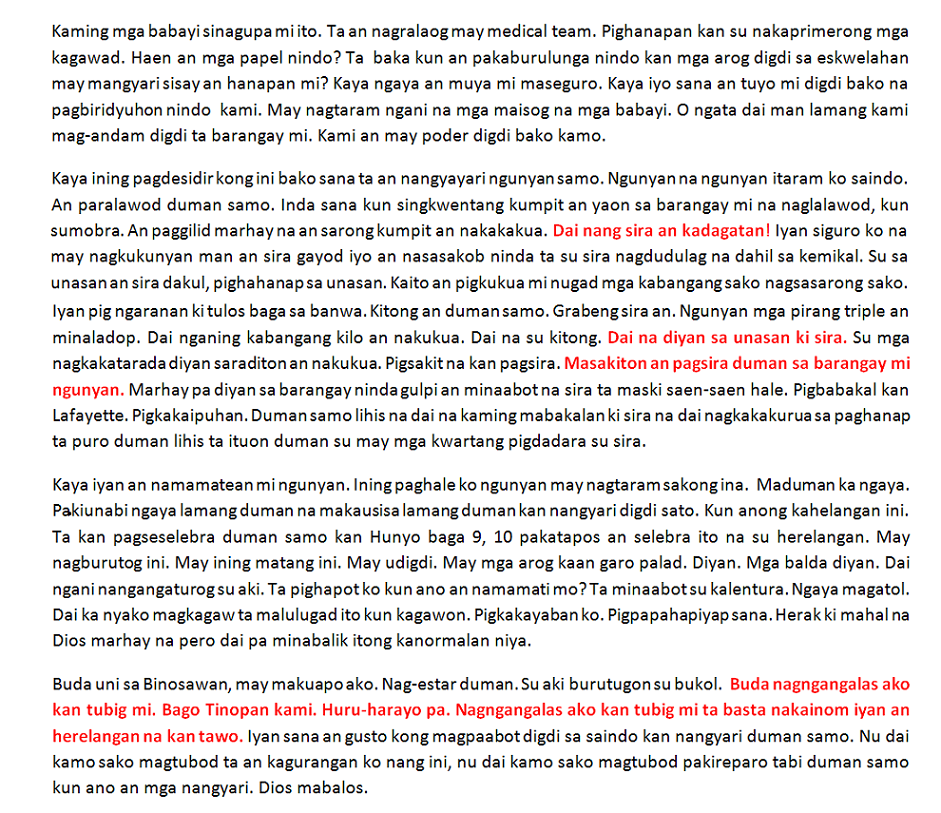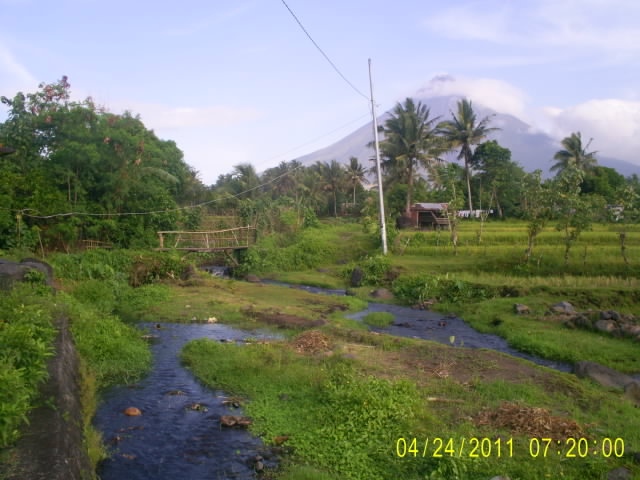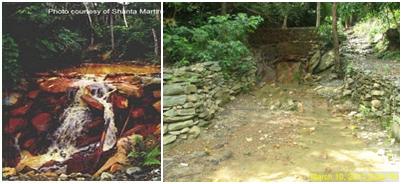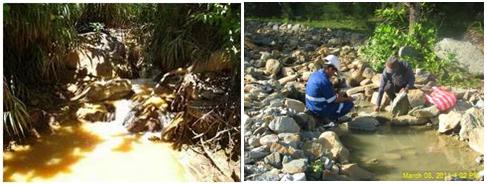Don’t be deceived
Lafayette’s media spin is on a roll these days. Here are some bitter truths to counter their sugary promises and lies.
1. Lafayette is operating business-as-usual. Sure. If you consider “business-as-usual” the following:
a. Lafayette could not pay its debts to Leighton.
b. Lafayette doesn’t have the capacity to meet its obligations, thus it had to run to the courts for protection from its creditors.
c. Lafayette, the parent company in Australia, is now under new administration and being ran by the banks.
d. Albay Governor Salceda says Lafayette’s current financial debacle is proof-positive of systemic bad management.
2. It is the biggest company and employer in these parts of the country. Granted. But it is not the biggest employer of Albayanos. And how many people from Rapu-Rapu does it actually employ? In May 2007, a company official boasted that they employ a whooping total of 131 Rapu-Rapu locals among their personnel. 131 is less than 0.5% of the town’s total population! Now what about the majority of Rapu-Rapu’s residents whose lives depends on fishing and whose fish catch have been considerably reduced since Lafayette started mining their island? While a small number benefits a little, the vast majority in Rapu-Rapu suffers loss of livelihood.
Lafayette may actually be the biggest company in these parts. That’s why it was able to secure for itself an anomalous Eco-Processing Zone status (read: tax holiday galore at the expense of the Filipino people). To quote Governor Salceda: “When they bullied the President in writing to get their PEZA, I knew something was not right with these people from the start”.
3. “The company continues to take care of its host communities, one of the poorest in the entire country.” Agabin outlined his company’s efforts: They have feeding programs. They have been trying to drastically raise the quality of education on the island. They introduced livelihood projects, sanitation facilities to promote hygiene, built roads and provided free electricity and water to its host communities. They paid an excise tax worth P26 Million.
Is your mind now filled with 30-sec TV ad images of smiling Rapu-Rapu residents, fishermen happily going about their work, company workers milling about with the locals, doing works of charity, apt music thumping in the background? We also imagined so... for a moment. If only such images were true. Behind the façade of these “social services” lies the dark side the company wishes you don’t explore: the fish kills, the destruction of the environment, the encroachment of more then 80% of the island’s territory, the harassment of researchers and locals alike, the death of Maurita de Ramas and Rosalie Ebrada, the demolition jobs against anti-Lafayette advocates, the lies, deceptions and corruption the company fosters on local residents, members of the media and government officials.
To quote a previous blog (“Another group showing interest in Lafayette?”; http://saverapurapu.blogspot.com/2008/01/second-group-shows-interest-in.html):
"A closer look at Lafayette’s social development projects will reveal, not only that most of these are palliative in nature, but also that their beneficiaries are limited mainly to residents of barangays Pagcolbon, Binosawan and Malobago where the mine site is located. Apparently, they are designed to gain the loyalty of, at least, a segment of Rapu-Rapu’s population and to project the company’s supposed socially-responsible image. Nice plan, but, as they say, the devil is in the details. Whether there is significant economic improvement in the lives of most of these programs’ beneficiaries is another matter altogether."
"In a recent people’s forum in Rapu-Rapu, Dean Virgilio Perdigon Jr., of Aquinas University’s Polytechnic Institute, presented Lafayette’s proclaimed social development projects. To each of them, the people gathered there resoundingly cried out 'buwa!', the local word for 'lie'."
"The road, water and electricity projects are also situated (you guessed it!) in the barangays where the mine operates and its workers reside. These projects are there primarily because Lafayette needs them for its operations."
"There are even reports of occasional harassments committed against researchers and even Rapu-Rapu residents just to pass through this road. How would you feel if you were a Rapu-Rapu resident and you would be required either by Lafayette’s 'blue guards' or by Lafayette-subsidized barangay security personnel to write your name on a logbook, stating the time and purpose of visit, every time you pass through this road? Still think Rapu-Rapu residents should be grateful to Lafayette for providing them roads, water and electricity? Think again."
4. “Some groups, including the Left, continue to seek its closure using alternatively scare tactics and hoaxes.” How about some groups who can’t be bought? How about some groups who dare to defy the might of a recidivist multinational giant? How about some groups who stand for the truth, social justice and sustainable development?
If you want to know about scare tactics, ask Rapu-Rapu residents and researchers who happened to enter “Lafayette territory” (read: barangays where the mine site is located), ask about their experiences with Lafayette’s “blue guards”, with pro-Lafayette barangay officials and Lafayette-subsidized barangay security personnel.
As to hoaxes, here are some quotes from a previous blog (“Will the real leaders and residents of Rapu-Rapu please stand up?”; http://saverapurapu.blogspot.com/2007/12/will-real-leaders-and-residents-of-rapu.html):
“Calling all fish kill incidents a hoax and a result of sabotage is now a widely-recognized standard Lafayette excuse. Also it is an observed human trait that when one lies so many times, there comes a point when even the liar believes his own lies.”
“The most recent fish kill in Rapu-Rapu was observed from 27 October to 2 November 2007. The people in Poblacion witnessed it. People from other barangays witnessed similar incidents in their places too. The number of food poisoning cases was up not just in Poblacion but in other barangays as well.”
“Another round of fish kill incidents happened on 13, 21 and 22 July 2006, well within the 30-day test run. Lafayette officials were quick to cry sabotage and hoax. A company lawyer even went as far as laying the blame on a priest assigned in Rapu-Rapu.”
Hoax was also how Lafayette officials described the 2005 fish kills. They denied for as long as they could, and when their lies were roundly disproved, they made an ambivalent public show of admission by coming up with a ridiculously long slogan: “It is better to light a candle for responsible mining than just to curse the darkness of past environmental sins.”
Still think Lafayette is compliant with Philippine laws? Committed to the well-being of Rapu-Rapu? Practices responsible mining and environmental protection?
Don’t be deceived.
Rapu Rapu exports copper to China01/09/2008
http://www.tribune.net.ph/business/20080109bus11.html
The Rapu Rapu polymetallic project is scheduled to ship 2,700 dry metric tons of copper concentrates worth almost $5 million to China this week.
“We are operating on a business-as-usual mode and are at the same time negotiating with at least three groups of interested investors to raise new capital,” said lawyer Bayani Agabin, spokesman for the Lafayette group, which manages the project.
Another foreign group, represented by a New York investment bank, also expressed interest only yesterday in the project, the biggest company and employer not only in Albay but the whole Bicol Region.
“This shipment belies reports of our bankruptcy and closure. We have not laid off employees and will not lay off anyone. Bankruptcy means closure of the project and letting go of all the employees. We are only going through rehabilitation which will allow us to continue operating and employing people while raising additional capital,” he said.
“We are operating within the law and are fully compliant with all our covenants, including protecting the environment through responsible mining. Rehabilitation is a common financial and legal remedy sought by companies with liquidity issues such as Philippine Airlines and Maynilad,” he said.
He added the environmental management system (EMS) of the processing plant has already been certified under ISO 14001. This January, the EMS of the mining component of the project will start undergoing a similar ISO certification audit to ensure the project’s full and continuing compliance with environmental standards.
The company continues to take care of its host communities, one of the poorest in the entire country, he said.
“We have a feeding program for children because fishermen, especially during the rainy season, cannot fish and could feed their children only once a day. We have been trying to drastically raise the quality of education on the island where two different elementary grades are taught by only one teacher at the same time,” he said.
He added the project has introduced livelihood projects, sanitation facilities to promote hygiene, built roads and provided free electricity and water to its host communities. It also paid excise taxes worth P26 million last year although it was just ramping up production.
While the project has been the island’s benefactor, he said some groups, including the Left, continue to seek its closure using alternatively scare tactics and hoaxes.
































































































































No comments:
Post a Comment